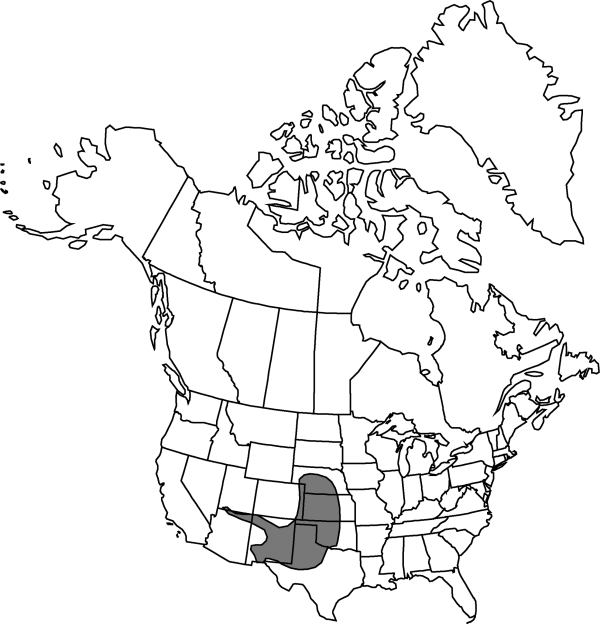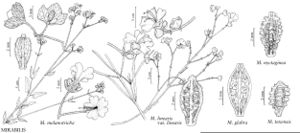Difference between revisions of "Mirabilis glabra"
Publ. Field Mus. Nat. Hist., Bot. Ser. 8: 304. 1931.
FNA>Volume Importer |
imported>Volume Importer |
||
| (7 intermediate revisions by 2 users not shown) | |||
| Line 7: | Line 7: | ||
|year=1931 | |year=1931 | ||
}} | }} | ||
| − | |basionyms={{Treatment/ID/ | + | |special_status={{Treatment/ID/Special_status |
| + | |code=F | ||
| + | |label=Illustrated | ||
| + | }} | ||
| + | |basionyms={{Treatment/ID/Basionym | ||
|name=Oxybaphus glaber | |name=Oxybaphus glaber | ||
|authority=S. Watson | |authority=S. Watson | ||
| + | |rank=species | ||
| + | |publication_title=Amer. Naturalist | ||
| + | |publication_place=7: 302. 1873 | ||
}} | }} | ||
|synonyms={{Treatment/ID/Synonym | |synonyms={{Treatment/ID/Synonym | ||
|name=Allionia carletonii | |name=Allionia carletonii | ||
|authority=Standley | |authority=Standley | ||
| − | }}{{Treatment/ID/Synonym | + | |rank=species |
| + | }} {{Treatment/ID/Synonym | ||
|name=Allionia exaltata | |name=Allionia exaltata | ||
|authority=Standley | |authority=Standley | ||
| − | }}{{Treatment/ID/Synonym | + | |rank=species |
| + | }} {{Treatment/ID/Synonym | ||
|name=Allionia glabra | |name=Allionia glabra | ||
|authority=(S. Watson) Kuntze | |authority=(S. Watson) Kuntze | ||
| − | }}{{Treatment/ID/Synonym | + | |rank=species |
| + | }} {{Treatment/ID/Synonym | ||
|name=Mirabilis carletonii | |name=Mirabilis carletonii | ||
|authority=(Standley) Standley | |authority=(Standley) Standley | ||
| − | }}{{Treatment/ID/Synonym | + | |rank=species |
| + | }} {{Treatment/ID/Synonym | ||
|name=Mirabilis exaltata | |name=Mirabilis exaltata | ||
|authority=(Standley) Standley | |authority=(Standley) Standley | ||
| − | }}{{Treatment/ID/Synonym | + | |rank=species |
| + | }} {{Treatment/ID/Synonym | ||
|name=Oxybaphus carletonii | |name=Oxybaphus carletonii | ||
|authority=(Standley) Weatherby | |authority=(Standley) Weatherby | ||
| − | }}{{Treatment/ID/Synonym | + | |rank=species |
| + | }} {{Treatment/ID/Synonym | ||
|name=Oxybaphus exaltatus | |name=Oxybaphus exaltatus | ||
|authority=(Standley) Weatherby | |authority=(Standley) Weatherby | ||
| + | |rank=species | ||
}} | }} | ||
|hierarchy=Nyctaginaceae;Mirabilis;Mirabilis sect. Oxybaphus;Mirabilis glabra | |hierarchy=Nyctaginaceae;Mirabilis;Mirabilis sect. Oxybaphus;Mirabilis glabra | ||
| Line 40: | Line 54: | ||
}}<!-- | }}<!-- | ||
| − | --><span class="statement" id="st- | + | --><span class="statement" id="st-undefined" data-properties=""><b>Stems </b>erect or ascending, sparsely to moderately leafy mostly in proximal 2/3, narrowly forked, usually with main axis, 5–20 dm, glabrous, glandular-puberulent, or puberulent with curved hairs, when pubescent, hairs usually densest distally. <b>Leaves</b> strongly ascending at 5–25°, progressively reduced toward inflorescence; petiole 0–1.3 cm; blade glaucous or grayish green, linear to narrowly ovate or ovate-oblong, 5–10 × 0.2–7.5 cm, thick and somewhat coriaceous, base attenuate to obtuse, round, truncate, or subcordate, apex acute to obtuse, occasionally round, surfaces glabrous to short pilose. <b>Inflorescences</b> usually terminal, sometimes also with short branches in distal axils, open, with main axis and short branches; peduncle 5–10 mm, usually spreading glandular-pilose, sometimes merely puberulent or glabrous, crosswalls of hairs pale; involucres pale green, widely bell-shaped, 3–6 mm in flower, 7–12 mm in fruit, glabrous except for few small hairs on margins to spreading glandular-pilose, 60–90% connate, lobes broadly ovate, rounded. <b>Flowers</b> 1–3 per involucre; perianth white to pale pink, 0.6–0.9 cm. <b>Fruits</b> grayish to greenish brown (ribs usually paler), narrowly obovate and tapering at both ends, 4–5.5 mm, usually glabrous, sometimes very lightly puberulent with hairs 0.1 mm; ribs narrow and keel-like to acute or acute-rounded, 0.2–0.5 times width of sulci, 0.5 times as wide as high, smooth; sulci lightly to prominently tuberculate.</span><!-- |
-->{{Treatment/Body | -->{{Treatment/Body | ||
| + | |phenology=Flowering late spring–early fall. | ||
|habitat=Sandy soils in grasslands or among oaks, juniper, or mesquite, disturbed areas | |habitat=Sandy soils in grasslands or among oaks, juniper, or mesquite, disturbed areas | ||
|elevation=500-2100 m | |elevation=500-2100 m | ||
|distribution=Ariz.;Colo.;Kans.;Nebr.;N.Mex.;Okla.;Tex.;Utah;Mexico (Chihuahua). | |distribution=Ariz.;Colo.;Kans.;Nebr.;N.Mex.;Okla.;Tex.;Utah;Mexico (Chihuahua). | ||
| − | |discussion=<p>As traditionally treated, Mirabilis carletonii (stems short pilose) and M. exaltata (stems glabrous), both from the eastern portion of the range of M. glabra, have leaves broader than 10 mm. Correlated with this is the presence of two to three flowers in the involucres. The narrower-leaved M. glabra, in the strict sense, has one or occasionally two flowers per involucre.</p> | + | |discussion=<p>As traditionally treated, <i>Mirabilis</i> carletonii (stems short pilose) and M. exaltata (stems glabrous), both from the eastern portion of the range of <i>M. glabra</i>, have leaves broader than 10 mm. Correlated with this is the presence of two to three flowers in the involucres. The narrower-leaved <i>M. glabra</i>, in the strict sense, has one or occasionally two flowers per involucre.</p> |
|tables= | |tables= | ||
|references= | |references= | ||
| Line 55: | Line 70: | ||
-->{{#Taxon: | -->{{#Taxon: | ||
name=Mirabilis glabra | name=Mirabilis glabra | ||
| − | |||
|authority=(S. Watson) Standley | |authority=(S. Watson) Standley | ||
|rank=species | |rank=species | ||
| Line 62: | Line 76: | ||
|basionyms=Oxybaphus glaber | |basionyms=Oxybaphus glaber | ||
|family=Nyctaginaceae | |family=Nyctaginaceae | ||
| + | |phenology=Flowering late spring–early fall. | ||
|habitat=Sandy soils in grasslands or among oaks, juniper, or mesquite, disturbed areas | |habitat=Sandy soils in grasslands or among oaks, juniper, or mesquite, disturbed areas | ||
|elevation=500-2100 m | |elevation=500-2100 m | ||
| Line 68: | Line 83: | ||
|publication title=Publ. Field Mus. Nat. Hist., Bot. Ser. | |publication title=Publ. Field Mus. Nat. Hist., Bot. Ser. | ||
|publication year=1931 | |publication year=1931 | ||
| − | |special status= | + | |special status=Illustrated |
| − | |source xml=https:// | + | |source xml=https://bitbucket.org/aafc-mbb/fna-data-curation/src/2e0870ddd59836b60bcf96646a41e87ea5a5943a/coarse_grained_fna_xml/V4/V4_108.xml |
|genus=Mirabilis | |genus=Mirabilis | ||
|section=Mirabilis sect. Oxybaphus | |section=Mirabilis sect. Oxybaphus | ||
|species=Mirabilis glabra | |species=Mirabilis glabra | ||
| − | |||
| − | |||
| − | |||
| − | |||
| − | |||
| − | |||
| − | |||
| − | |||
| − | |||
| − | |||
| − | |||
| − | |||
| − | |||
| − | |||
| − | |||
| − | |||
| − | |||
| − | |||
| − | |||
| − | |||
| − | |||
| − | |||
| − | |||
| − | |||
| − | |||
| − | |||
| − | |||
| − | |||
| − | |||
| − | |||
| − | |||
| − | |||
| − | |||
| − | |||
| − | |||
| − | |||
| − | |||
| − | |||
| − | |||
| − | |||
| − | |||
| − | |||
| − | |||
| − | |||
| − | |||
| − | |||
| − | |||
| − | |||
| − | |||
}}<!-- | }}<!-- | ||
-->[[Category:Treatment]][[Category:Mirabilis sect. Oxybaphus]] | -->[[Category:Treatment]][[Category:Mirabilis sect. Oxybaphus]] | ||
Latest revision as of 22:56, 5 November 2020
Stems erect or ascending, sparsely to moderately leafy mostly in proximal 2/3, narrowly forked, usually with main axis, 5–20 dm, glabrous, glandular-puberulent, or puberulent with curved hairs, when pubescent, hairs usually densest distally. Leaves strongly ascending at 5–25°, progressively reduced toward inflorescence; petiole 0–1.3 cm; blade glaucous or grayish green, linear to narrowly ovate or ovate-oblong, 5–10 × 0.2–7.5 cm, thick and somewhat coriaceous, base attenuate to obtuse, round, truncate, or subcordate, apex acute to obtuse, occasionally round, surfaces glabrous to short pilose. Inflorescences usually terminal, sometimes also with short branches in distal axils, open, with main axis and short branches; peduncle 5–10 mm, usually spreading glandular-pilose, sometimes merely puberulent or glabrous, crosswalls of hairs pale; involucres pale green, widely bell-shaped, 3–6 mm in flower, 7–12 mm in fruit, glabrous except for few small hairs on margins to spreading glandular-pilose, 60–90% connate, lobes broadly ovate, rounded. Flowers 1–3 per involucre; perianth white to pale pink, 0.6–0.9 cm. Fruits grayish to greenish brown (ribs usually paler), narrowly obovate and tapering at both ends, 4–5.5 mm, usually glabrous, sometimes very lightly puberulent with hairs 0.1 mm; ribs narrow and keel-like to acute or acute-rounded, 0.2–0.5 times width of sulci, 0.5 times as wide as high, smooth; sulci lightly to prominently tuberculate.
Phenology: Flowering late spring–early fall.
Habitat: Sandy soils in grasslands or among oaks, juniper, or mesquite, disturbed areas
Elevation: 500-2100 m
Distribution

Ariz., Colo., Kans., Nebr., N.Mex., Okla., Tex., Utah, Mexico (Chihuahua).
Discussion
As traditionally treated, Mirabilis carletonii (stems short pilose) and M. exaltata (stems glabrous), both from the eastern portion of the range of M. glabra, have leaves broader than 10 mm. Correlated with this is the presence of two to three flowers in the involucres. The narrower-leaved M. glabra, in the strict sense, has one or occasionally two flowers per involucre.
Selected References
None.
